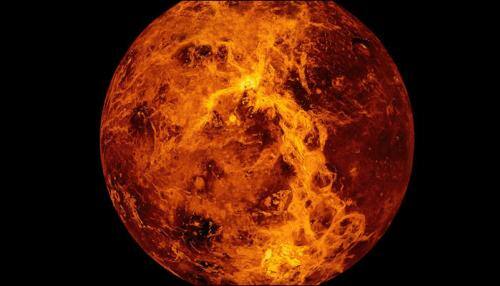- News>
- Space
Venus` mysterious night side revealed for the first time - Here`s why it`s creating a buzz

Venus` atmosphere is dominated by strong winds that whirl around the planet far faster than Venus itself rotates.
New Delhi: As of now, there are numerous spacecrafts circling around in space conducting probes on the different planets that comprise our solar system.
After Japan's Akatsuki probe discovered a massive 'bulge' in the Venus's atmosphere, the planet has once again created a stir among scientists, but this time, for a different reason.
Scientists have characterised wind and cloud patterns of the night side of planet Venus for the first time, and found that it behaves very differently from the part facing the Sun.
The night side exhibits unexpected and previously-unseen cloud types, morphologies, and dynamics – some of which appear to be connected to features on the planet's surface.
"This is the first time we've been able to characterise how the atmosphere circulates on the night side of Venus on a global scale," said Javier Peralta of the Japan Aerospace Exploration Agency (JAXA).
"While the atmospheric circulation on the planet's dayside has been extensively explored, there was still much to discover about the night side. We found that the cloud patterns there are different to those on the dayside, and influenced by Venus' topography," said Peralta, lead author of the study published in the journal Nature Astronomy.
Venus' atmosphere is dominated by strong winds that whirl around the planet far faster than Venus itself rotates.
This phenomenon, known as 'super-rotation', sees Venusian winds rotating up to 60 times faster than the planet below, pushing and dragging along clouds within the atmosphere as they go.
These clouds travel fastest at the upper cloud level, some 65 to 72 kilometres above the surface.
"We've spent decades studying these super-rotating winds by tracking how the upper clouds move on Venus' dayside these are clearly visible in images acquired in ultraviolet light," said Peralta.
"However, our models of Venus remain unable to reproduce this super-rotation, which clearly indicates that we might be missing some pieces of this puzzle," he said.
"We focused on the night side because it had been poorly explored; we can see the upper clouds on the planet's night side via their thermal emission, but it's been difficult to observe them properly because the contrast in our infrared images was too low to pick up enough detail," he added.
The team used the Visible and Infrared Thermal Imaging Spectrometer (VIRTIS) on European Space Agency (ESA)'s Venus Express spacecraft to observe the clouds in the infrared.
"VIRTIS enabled us to see these clouds properly for the first time, allowing us to explore what previous teams could not and we discovered unexpected and surprising results," adds Peralta.
Rather than capturing single images, VIRTIS gathered a 'cube' of hundreds of images of Venus acquired simultaneously at different wavelengths.
This allowed the team to combine numerous images to improve the visibility of the clouds, and see them at unprecedented quality.
The VIRTIS images thus reveal phenomena on Venus' night side that have never before been seen on the dayside.
(With PTI inputs)
